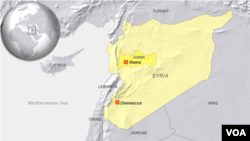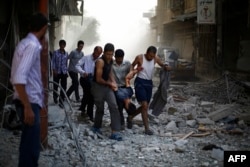Rebels with the Free Syrian Army repelled an offensive mounted Wednesday by forces loyal to President Bashar al-Assad in central Syria, destroying 10 government tanks — despite coming under repeated Russian air assault, their leaders claim.
But they say front-line militias fending off a Syrian government ground offensive in the countryside near Hama need more U.S. assistance and are critical of what they claim is a reversal in American policy to establish a safe haven in the northern part of the war-torn country.
Free Syrian Army leaders say they thought they had an agreement on a buffer zone weeks ago and are mystified U.S. officials are now saying publicly that an American-enforced no-fly zone is a no-go.
“The regime’s losses were great yesterday,” Ahmad Tu’mah, the prime minister of the Syrian Interim Government that was set up by a coalition of Western-backed opposition groups, told VOA in an exclusive interview Thursday in the Turkish border city of Gaziantep.
Some militia commanders reported on social media sites Wednesday night that they had destroyed 25 tanks and captured two T-72 tanks. But Tu’mah puts the number lower, saying, “At least 10 tanks were destroyed.” Even so, he characterized the toll as “a serious loss for the regime.”
“If we had more TOW anti-tank missiles we could do more,” he added.
The relief on the faces of fighters from the FSA’s 101st and 13th Divisions in video and still photographs posted on social media after their daylong clashes with Syrian regulars paid testimony to the setback they feel they have dealt to Syrian government forces. Both divisions were among the first to receive U.S.-made BGM-71 TOW anti-tank missiles. But commanders say supplies have been coming in dribs and drabs, and in numbers insufficient for their battlefield needs.
The government ground offensive in the northern Hama countryside, which started in earnest at midweek, is focused chiefly on Kernaz and Kafranbooda, and civilians from both villages have been fleeing to a neighboring province and to adjacent olive tree orchards.
On Thursday morning, FSA rebels claimed to have downed two regime helicopters that were mounting a coordinated air assault with Russian warplanes on the village of al-Mugheer. Separately from FSA brigades, militiamen with the Islamist Ahrar-al-Sham militia, part of the Army of Conquest alliance that coordinates with al-Qaida’s affiliate in Syria, Jabhat al-Nusra, claimed to have captured a T-72 tank and destroyed regime tanks and armored vehicles.
No Fly Zone
Tu’mah expressed frustration — as well as confusion — over the Obama administration’s position on establishing a buffer zone in northern Syria — one that would be secure from Syrian airstrikes. He claims U.S. officials told them during the summer that a buffer zone would be established — part of a deal with the Turks for the use of the NATO airbase at Incirlik in southern Turkey by U.S.-led coalition warplanes to strike Islamic State extremists.
“It is very strange indeed …suddenly the Americans said there was no agreement at all,” he told VOA.
On Wednesday, U.S. State Department spokesman Admiral John Kirby told reporters: “There’s been no decision to move forward with a no-fly zone. There are a lot of challenges, as we’ve noted, with doing a no-fly zone, and not least of which is an issue of resources.” He said that discussions about some kind of buffer zone are continuing. But CNN quoted U.S. officials this week saying President Obama had rejected the buffer zone proposal at a National Security Council meeting on October 1.
In July, Turkish officials said they secured an agreement with the Obama administration to jointly secure a zone in a small part of northern Syria. But, as VOA reported at the time, U.S. officials, while confirming the broad outlines of the deal, said there were discrepancies in how Washington and Ankara viewed the buffer zone, suggesting a final accord was proving elusive.
Syrian/Russian Ground Troops
Now, with the Russian intervention, Tu’mah acknowledges the issue of a no-fly zone has gotten even more complicated. Of the fighting flaring in central Syria, he told VOA Syrian government soldiers form the bulk of the forces launching the ground offensive — and despite media reports to the contrary, Russian soldiers are present but only in small numbers. He added there are large numbers of Iranian and foreign Shia Muslim fighters from Iraq and Lebanon, but they are concentrated in western Syria near the border with Lebanon.













